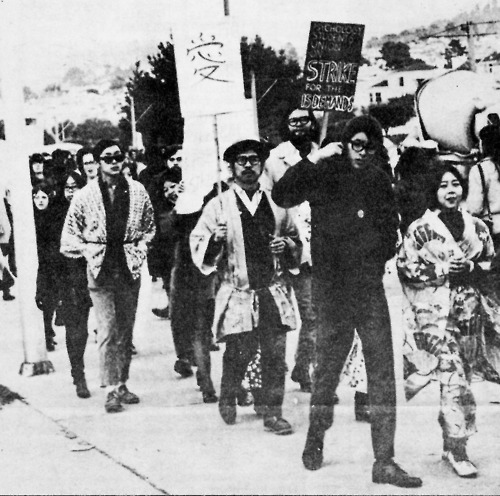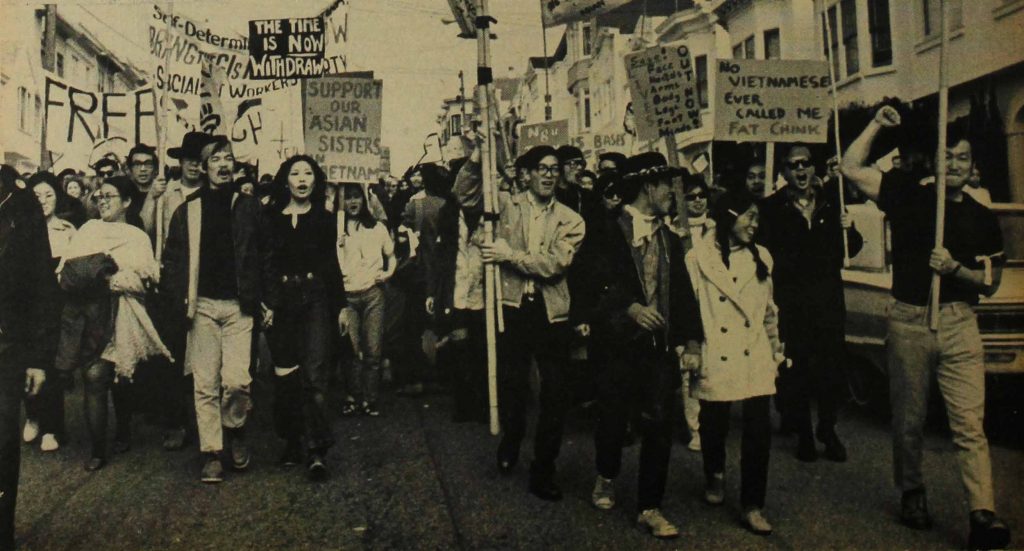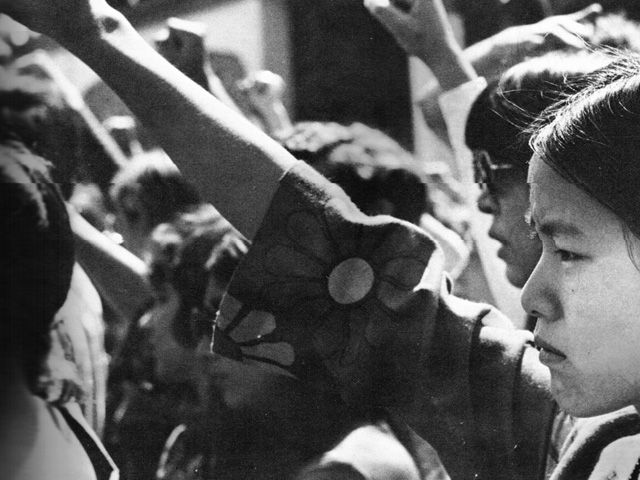May 8, 2017
Prior to the social and political upheavals of the 1960s, there was no “Asian America” — at least not as we know it today. While Americans of Asian descent had joined forces on the picket line and plantation field throughout history, their identities and struggles were mostly defined along distinct ethnic lines. But amidst the tumult of the civil rights movement, young people united their communities to forge a new identity based on their collective experiences as Asian Americans.
When Janice Mirikitani was 5 years old, she cut off the blonde hair from her favorite doll and glued it to her own head, hoping it would magically transform her into a blonde-haired, blue-eyed, all-American girl. Like so many girls (and boys) of color, she had internalized a “sense of unworthiness and self-hatred” growing up immersed in a culture that constantly told her she wasn’t good enough.
The Asian American movement, as it would come to be known, was a political awakening for young activists like Mirikitani—wrestling with stereotypes and questions of identity, caught between the myth of the American Dream and the reality that it was not meant for people who looked like them, angry at the historical degradations their parents and grandparents had been forced to endure. Embracing their Asian American identity as a source of power and pride, they soon channeled those frustrations into concrete action.
Naming Asian America
The notion of Asian America was rooted in a pan-Asian identity that would harness the power of a “consolidated yellow people” against the forces of racism and imperialism. Inspired by the radical politics of the Black Liberation Movement and frustrated with white progressives’ failure to engage with race in a meaningful way, Asian Americans set out to create their own movement.
Yuji Ichioka, who taught the first Asian American studies class at UCLA, is credited with coining the term “Asian American” in 1968. He and his partner Emma Gee, then student activists at UC Berkeley, founded the Asian American Political Alliance out of their living room that summer, adopting the name to unify previously separate groups of ethnic Asian students—and to subvert the “Oriental” trope thrust on them by whites unable (and unwilling) to differentiate between them. As the (in)famous Richard Aoki put it, “Oriental was a rug that everyone steps on, so we ain’t no Orientals. We were Asian American.”1
Although there was some pushback—especially from Filipinos and others who felt marginalized within the larger Asian American community2—this self-determined label caught on and began to spread as additional AAPA chapters and other pan-Asian organizations sprouted up across the country, both on and off campus. In just two years there were at least forty grassroots organizations, four newspapers, and ten student and community conferences flying the Asian American flag.3
The Third World Revolution

The Third World Liberation Front Strikes of 1968-69 were a defining moment for the burgeoning Asian American movement. At San Francisco State, AAPA (which was mostly limited to Japanese, in practice if not in theory), Intercollegiate Chinese for Social Action, and the Pilipino-American Collegiate Endeavor came together to form the “Asian contingent” of the student-led strike. From November 1968 to March 1969—the longest student strike in U.S. history—Asian American, Black, Chicano, and Native students clashed with administrators, and occasionally police, to establish an ethnic studies department and increase the number of students and faculty of color at the school. A second strike took place at UC Berkeley from January to March 1969.
These strikes were heavily publicized, and helped upend popular depictions of Asian Americans as quiet foreigners forever striving to assimilate into white society. By choosing Third World solidarity over model minority complicity—not only during the strikes, but also in support of the United Farm Workers, Native occupations at Alcatraz and Wounded Knee, the Free Huey campaign, and other concurrent issues—Asian Americans rejected “the passive Oriental stereotype” in favor of “a new Asian… who will recognize and fight injustices.”4
But students were not the movement’s only “first responders.” Triple A founders Kazu Iijima and Minn Matsuda had been politically active for over 30 years by the time the Asian American movement really got going. Larry Itliong was 52 and Philip Vera Cruz 61 when they established the Agricultural Workers Organizing Committee, and Grace Lee Boggs had been involved with the Black Liberation Movement since the 1940s. Many of these “over thirties” were “the initial impetus for the politicization of young people,” and their early efforts to cross racial divides and break the silence around Asian American struggles for equity provided an important foundation for their younger counterparts.5
“No Vietnamese Ever Called Me Chink”

Another major factor in the origins of the Asian American movement was the Vietnam War. Asian Americans felt impelled to end the conflict not just for the sake of peace or bringing home “our” (not “their”) boys. They also recognized the racist and colonialist implications of the U.S. involvement in Vietnam, and linked the slaughter of “gooks” in Southeast Asia to the brutal Philippine-American War, Hiroshima, Nagasaki, and the long history of violence perpetrated against Asian peoples throughout U.S. history.
Third World organizer Patsy Chan described this Asian American perspective:
“The vicious imperialism which seeks to commit total genocide against the proud people of Indochina is the same imperialism which oppresses those of us here in the US by creating dehumanizing conditions in our Asian communities, barrios, black ghettos and reservations.”6
Tired of being treated like token minorities and dismissed as “divisive” each time they brought up the “deadly disdain for all persons of Asian ancestry” promoted by the war, Asian Americans branched off into their own anti-war movement. (And continued protesting into the 1970s, when a decline in American casualties resulted in a decline in white outrage.)7
Serving the People

As American aggression threatened Asians abroad, urban renewal took its toll on communities closer to home. Little Tokyos, Chinatowns and Manilatowns across the country—created by historical segregation and located on land that had since become prime real estate—were cast as blighted and impoverished ghettos in desperate need of “revitalization.” Developers began to push out the elderly and low-income residents who had built these neighborhoods, erasing their history in the process.
So student activists radicalized by the TWLF strikes and anti-war movement, gang members mobilized against drug addiction and police violence, and elders facing eviction joined forces in the fight to preserve historic Asian American neighborhoods and provide services to the people living there. Groups like the Red Guard, I Wor Kuen, Yellow Brotherhood, Kalayaan mga Demokratikong Pilipino, and Asian American Hardcore occupied contested land, established community centers and health clinics, and organized initiatives modeled after the Black Panther Party’s free breakfast program. At city hall and in the streets, anti-eviction task forces and tenant unions put pressure on developers to halt displacement and prioritize affordable senior housing.
It was an uphill battle that was not entirely successful, but Asian American activists did manage to get local governments and redevelopment agencies to cough up relocation assistance for residents, small businesses and community groups forced to move, and in some cases stalled or even stopped evictions.
Asian America Today
The list of struggles taken on by the Asian American movement is long and by no means fully represented here. Far more comprehensive accounts include the campaign to repeal Title II of the Internal Security Act; labor strikes and unionization efforts by farm laborers, factory workers and Alaskeros; land disputes in Hawai’i; and the push for reparations for the WWII incarceration of Japanese Americans—to name but a few.
So where is this “yellow consciousness” now?
Many of the same conditions that fomented its rise persist today: degrading stereotypes that paint Asians as meek, passive Orientals; the weaponization of those stereotypes against Black Americans whose children are being killed in the streets; gentrification that threatens to erase our communities’ historic foundations and displace our elders; military involvements in faraway “savage” lands that amplify hate and violence toward Americans who happen to look like our supposed enemies.
The problems that plagued the movement also persist. South Asians, West Asians, Black Asians, queer Asians, and other marginalized members of the community are still being erased. Brorientals are still blaming Asian women for their emasculation while ignoring our hyper-sexualization. All of us are still not doing enough to support the Black folks who are still leading the revolution.
But much has changed, as well. Whereas the original movement was led by Japanese, Chinese and Filipinos who made up the vast majority of Asian Americans in the 1960s and 1970s, increased immigration, shifting demographics, and coalitions with Native Hawaiians and Pacific Islanders have changed the face of the community. As the nation’s fastest growing racial group—making up 6% of the total population, compared to less than .5% in 1960—Asian Americans today have a strength in numbers that previous generations did not.8
The question is, will we learn from our history, grow from it, and keep the movement alive until we are truly, fully free? Or will we retreat back into complicity in a system that values our obedience more than our lives?
—
By Nina Wallace, Densho Communications Coordinator
Citations:
- Interview with Diane Fujino. Samurai Among Panthers: Richard Aoki on Race, Resistance and a Paradoxical Life (Minneapolis: University of Minnesota Press, 2012).
- Violet Rabaya. “I Am Curious (Yellow?)” Gidra Vol. 1, No. 7 (October 1969): 7.
- Karen L. Ishizuka. Serve the People: Making Asian America in the Long Sixties (New York: Verso Books, 2016): 72.
- Larry Kubota. “Yellow Power.” Gidra Vol. 1, No. 1 (April 1969): 3-4.
- Ishizuka, 88-95.
- Patsy Chan. “End Your Racist War.” Gidra Vol. 3, No. 6 (June 1971): 5.
- William Wei. The Asian American Movement (Philadelphia: Temple University Press, 1993): 37-41.
- Asian American Center for Advancing Justice. A Community of Contrasts: Asian Americans in the United States (2011).
[Header photo: Oakland High School students participate in the funeral for Black Panther Bobby Hutton, killed by Oakland Police in 1968. Photo by Nikki Arai, courtesy of Asian American Movement 1968.]
